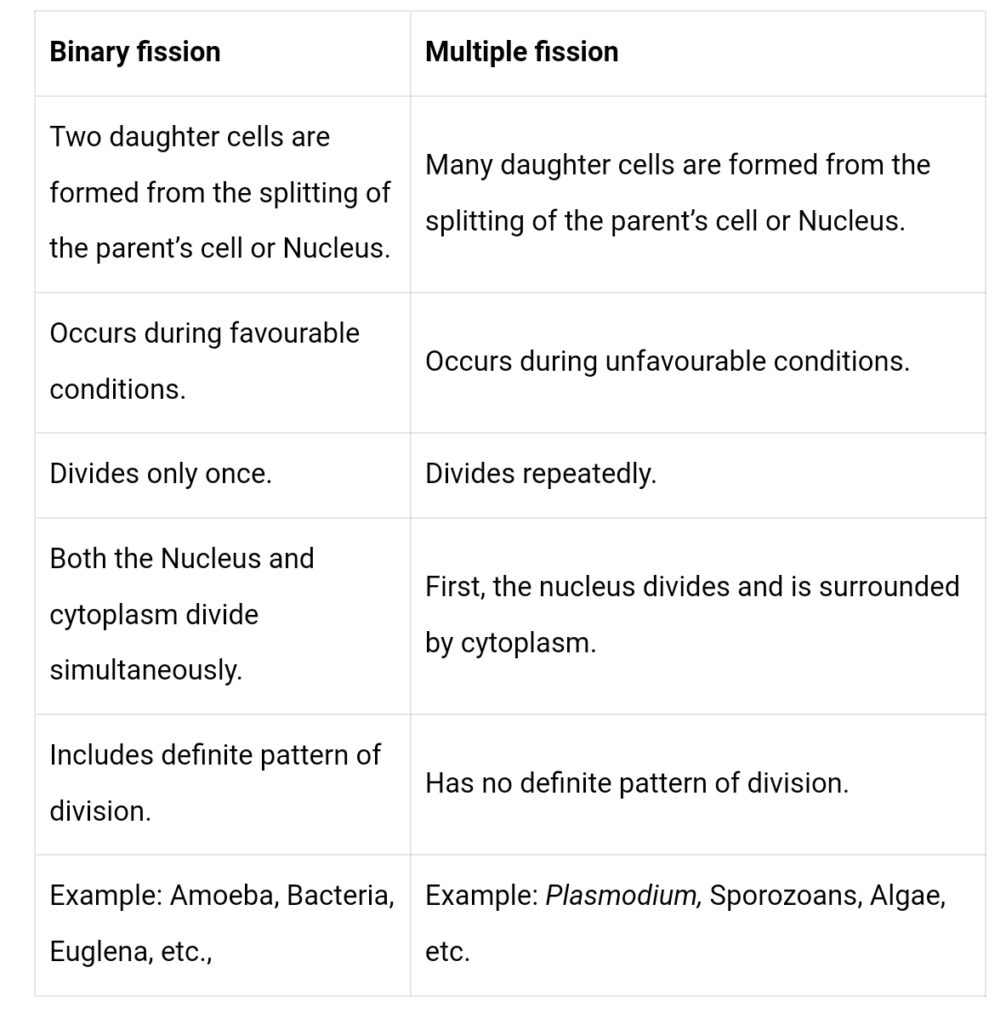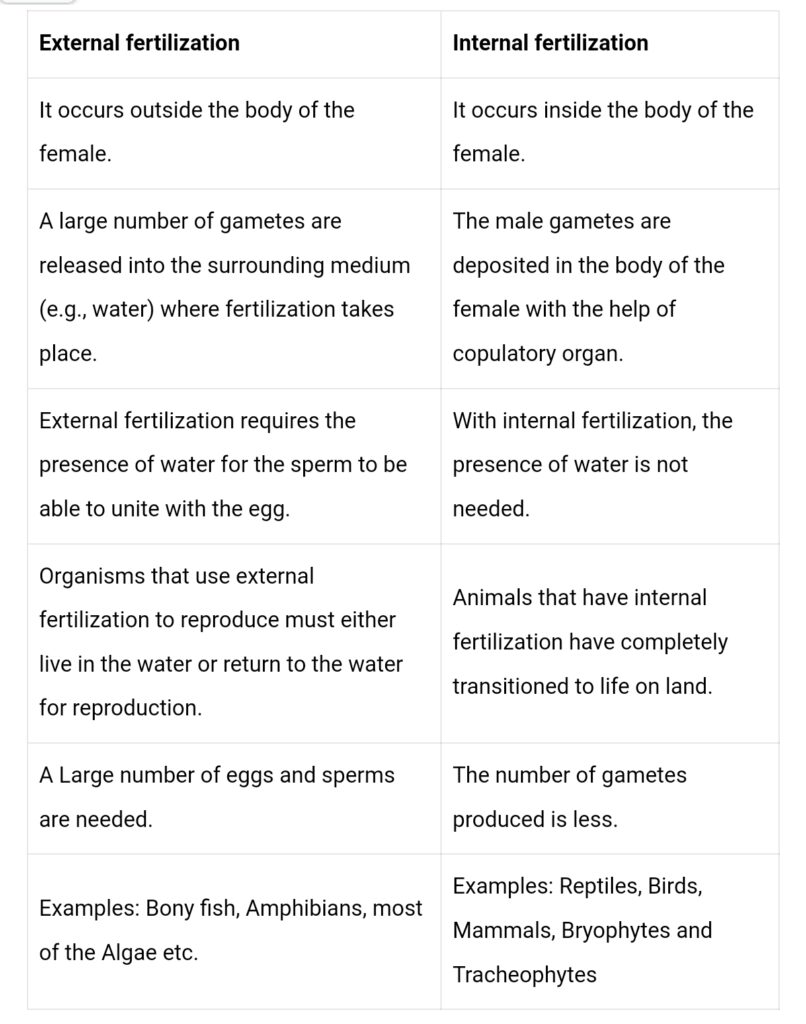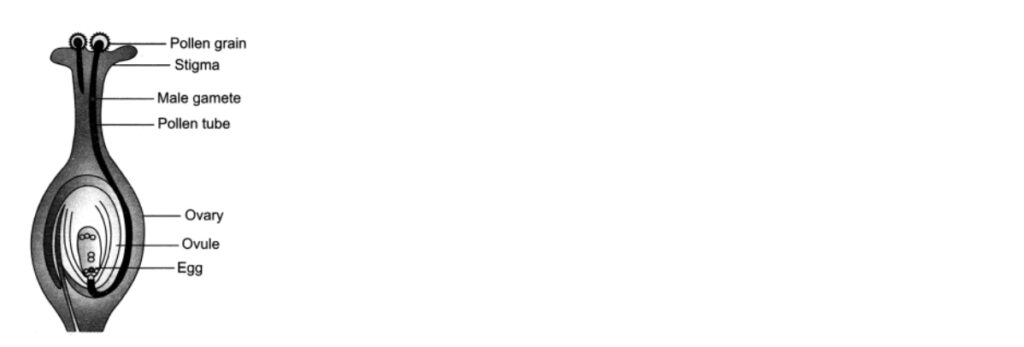We have provided you with Extra and Important Questions from Class 10 Science Chapter 8 How do Organisms Reproduce. This Extra and Important Questions will help you to score 100% in your Board Exams. These extra questions will be helpful to revise the important topics and concepts.
Join our Telegram Channel, there you will get various e-books for CBSE 2024 Boards exams for Class 9th, 10th, 11th, and 12th.
Table of Contents
How do Organisms Reproduce Class 10 Important Questions with Answers Science Chapter 8
Extra Questions for Class 10 Science Chapter 8 Very Short Answer Type
Question: Give one example for each of the following.
(а) Plants in which vegetative propagation occurs by grafting.
(b) Plants in which vegetative propagation occurs by leaves [CBSE 2012]
Answer: (a) Rose, grapes can be vegetatively propagated by grafting.
(b) Bryophyllum can be vegetatively propagated by leaves.
Question: What is the effect of DNA copying which is not perfectly accurate on the reproduction process?
Answer: DNA copying is not perfectly accurate and the resultant errors are a source of variations in populations of organisms.
Question: Mention the mode of reproduction used by
(a) Amoeba (b) Planaria.
Answer: Mode of reproduction used by
(a) Amoeba is Binary fission.
Question: Name the information source of making proteins in the cell. State two basic events in reproduction.
Answer: The information source for making proteins in the cell is deoxyribo nucleic acid (DNA)
The two basic events in reproduction is the replication of DNA and cell division.
Question: State the method used for growing rose plants.
Answer: Artificial methods of vegetative propagation like cutting are used to grow rose plants.
Question: State what type of method is used for growing jasmine plant.
Answer: Artificial methods of vegetative propagation like layering is used for growing jasmine plant.
Question: Name the largest cell present in the human body.
Answer: The largest cell present in the human body is ovum.
Question: What is ‘reproduction’? Mention the importance of DNA copying in reproduction.
Answer: Reproduction is the process of producing new individuals of the same species by existing organisms of a species, i.e. parents. The importance of DNA copying in reproduction are as follows:
(i) DNA copying is called DNA replication. In this process, one copy each of replicated DNA will be passed to daughter cells.
(ii) Variations may be introduced during DNA copying. This inbuilt tendency for variation during reproduction forms the basis of evolution.
Question: “Variations that confer an advantage to an individual organism only will survive in a population.” Justify.
Answer: It is because the chances of survival depend on the nature of variations and different individuals have different kinds of advantages.
For example: A bacteria that can withstand heat will survive better in a heat wave, i.e. the organisms that are fit in the competitive environment and with great variations will be able to survive and adapt. Thus, more offsprings and population with genetic variations will survive.
Question: Name one sexually transmitted disease each caused due to bacterial infection and viral infection. How can these be prevented?
Answer: Sexually transmitted disease caused due to
(i) Bacterial infection is gonorrhoea, and
Question: What is regeneration?
Answer: Regeneration is the ability of a fully differentiated organism to give rise to new individual organisms from its body parts.
Question: What is reproduction?
Answer: Reproduction is the process of producing new individuals of the same species by existing organisms of a species, i.e., parents.
Extra Questions for Class 10 Science Chapter 8 Short Answer Type
Question: List any four reasons for vegetative propagation being practised in the growth of some type of plants.
Answer:
- (i) Vegetative propagation is a cheaper, easier and more rapid method of propagation in plants than growing plants from their seeds.
- (ii) Better quality of plants can be maintained by this method.
- (iii) It results in propagation of those plants which do not produce viable seeds or produce seeds with prolonged period of dormancy.
- (iv) The plants generated from vegetative means are more uniform and genetically similar to the parent stock.
Question: Write differences between binary fission and multiple fission in a tabular form as observed in cells of organisms.
Answer:

Question: State one genetically different feature between sperms and eggs of humans. What is its consequence?
Answer: The sex chromosome of human male is XY. A sperm of human male carries either an X chromosome or one Y chromosome.
The sex chromosome of human female is XX and hence, the egg always carries the X chromosome.
If a sperm carrying X chromosome fertilises an egg which carries X chromosome, then the’ child born will be a girl. If a sperm carrying Y chromosome fertilises an egg which carries X chromosome, then the child born will be a boy.
Question: “DNA copies generated during reproduction will be similar but may not be identical to the original.” Justify this statement.
Answer: DNA copies generated will be similar, but may not be identical to the original as some variations are so drastic that new DNA copy cannot work with the cellular apparatus it inherits. Such a newborn cell will simply die. Therefore, there could be many other variations in the DNA copies that would not lead to such a drastic outcome. Thus, the surviving cells are similar but slightly different from each other. This tendency of variation during reproduction is the basis for evolution.
Question: (i) What is fertilisation? Distinguish between external fertilisation and internal fertilisation.(ii) What is the site of fertilisation in human beings?
Answer: (i) Fertilisation is defined as the fusion of a male gamete (sperm) with a female gamete (an ovum or egg) to form a zygote during sexual reproduction.

(ii) The site of fertilisation in human beings is in the fallopian tube of female reproductive system.
Question: Write the full form of DNA. Name the part of the cell where it is located. Explain its role in the process of reproduction of the cell.
Answer: The full form of DNA is deoxyribonucleic acid. It is the genetic material found in the chromosomes, which are present in the nucleus of a cell.
Role of DNA in the process of reproduction of the cell:
DNA plays an important role in the reproduction of a cell. The reproducing cell produces an identical copy of DNA through some cellular mechanism. Since the newly formed copy of DNA lacks an organised cellular structure, the cell gets divided to provide cell cover to the newly formed DNA. Thus, two daughter cells are formed from the single cell as a result of the copying of DNA.
Question: Explain vegetative propagation with the help of two examples. List two advantages of vegetative propagation.
Answer: In vegetative propagation, new plants are obtained from the parts of old plants like stems, roots and leaves, without the help of any reproductive organ.
There are two ways of vegetative propagation:
(a) Natural Vegetative Propagation, and
(b) Grafting: In this method of reproduction, two plants of closely related varieties are joined together so that they live as one plant
- The portion of a plant that is grafted on the other plant is called scion, and the plant in which grafting is performed is called the stock.
- This method is applied to improve variety of fruits like mango, apple, peas, citrus and guava. Advantages of vegetative propagation are:
(i) Vegetative propagation is a cheaper, easier and more rapid method of propagation in plants than growing plants from their seeds.
(ii) Better quality of the plants can be maintained by this method.
Question: What does HIV stand for? Is AIDS an infectious disease? List any four modes of spreading AIDS.
Answer: HIV stands for Human Immunodeficiency Virus.Yes, AIDS is an infectious disease.
Four modes of spreading AIDS are as follows:
- By having sexual contact with an infected person.
- By the transfusion of blood from an infected person.
- Through infected needles used for injection.
- Through the placenta from the mother to child during pregnancy.
Question: Explain the following methods of contraception giving one example of each:
(i) Barrier method
(ii) Hormonal imbalance method.
(iii) Surgical method
Answer: (i) Barrier Method: In this method, physical devices such as condoms, diaphragm and cervical caps are used. These devices prevent the entry of sperm in the female genital tract during copulation, thus acting ‘ as a barrier between them.
(ii) Hormonal Imbalance Method: In this method, specific drugs are used by females, which are of two types: oral pills and vaginal pills. Oral pills contain hormones which stop the ovaries from releasing ovum into the fallopian tube. These pills are also called oral contraceptives (OCs) which act by changing the hormonal balance of the body so that eggs are not released and fertilisation cannot occur. The use of Intrauterine Contraceptive Devices (IUCDs) prevents implantation in the uterus. This device is copper-T placed safely inside the uterus by a doctor or nurse.
(iii) Surgical Method: In this method, a small portion of vas deferens in male and the fallopian tube in ‘ female is surgically removed or tied. It is called vasectomy in males and tubectomy in females. In this case, if the vas deferens in male is blocked, sperm transfer will be prevented and if the fallopian tube in the female is blocked, the egg will not be able to reach the uterus, thus fertilisation will not take place.
Question: List and explain in brief three methods of contraception.
Answer: Methods of contraception are:
- Use of condom for penis or for vagina as a mechanical barrier for the sperms to reach the egg.
- Use of oral pills which change the hormonal balance so that eggs are not released.
- Surgical method where either the vas deferens of male is blocked or the fallopian tube of female is blocked.
Question: What is AIDS? Which microbe is responsible for AIDS infection? State one mode of transmission of this disease. Explain in brief one measure for the prevention of AIDS.
Answer: AIDS is the Acquired Immune Deficiency Syndrome. It is caused by a virus called Human Immunodeficiency Virus. AIDS is transmitted by sexual contact with an infected person. AIDS can be prevented by avoiding sexual contact with infected person or by using condom during sex.
Question: Name the kind of organisms that reproduce by spore formation. How will an organism be benefitted if it reproduces through spores? [CBSE 2013]
Answer: Rhizopus (Fungus) reproduces by spore formation. The organism is benefitted because the spores are covered by thick walls that protect them until they come in contact with a moist surface and begin to grow.
Extra Questions for Class 10 Science Chapter 8 Long Answer Type
Question: Write two points of difference between asexual and sexual types of reproduction. Describe why variations are observed in the offspring formed by sexual reproduction. [NCERT Exemplar]
Answer:
- Asexual Reproduction.
- Single parent is involved.
- No fusion of gametes occur.
- Progeny is genetically identical to the parent.
- For example, Fission in Amoeba
- Sexual Reproduction:
- Two parents are involved.
- Fusion of gametes occurs.
- Variations occur in the progeny.
- For example, Human beings
Fusion of gametes occurs during sexual reproduction. The gametes contain the same number of chromosomes but their DNA is not identical so variations arise among the offsprings.
Question: Distinguish between pollination and fertilisation. Mention the site and product of fertilisation in a flower. Draw a neat, labelled diagram of a pistil showing pollen tube growth and its entry into the ovule. [NCERT Exemplar]
Answer: Pollination: The transfer of pollen grains from the anther to the stigma of a flower is called pollination.Fertilisation: The process of fusion of male and female gametes to form a zygote is called fertilisation.The site of fertilisation is ovule. The product of fertilisation is zygote.

Question: Distinguish between a gamete and zygote. Explain their roles in sexual reproduction. [NCERT Exemplar]
Answer:The sex cell or germ cell in sexual reproduction is called gametes. There are two types of gametes, male and female. A male and a female gamete fuse with each other during fertilisation to form a zygote.
The gametes possess characters of their parents in their DNA and their fusion brings characters of both parents into one zygote cell. Zygote is the first cell of the next generation which divides to form an embryo which subsequently grows into a new individual.
Question: What is placenta? Mention its role during pregnancy. [NCERT Exemplar, CBSE 2017]
Answer: A disc shaped special tissue connection between embryo and uterine wall is called placenta. It contains villi on the embryo’s side of the tissue which are surrounded by blood spaces on the mother’s side.
Roles of placenta are:
- It provides a large surface area for glucose and oxygen to pass from mother to the embryo.
- Removes waste substances produced by the developing embryo.
Question: What are various ways to avoid pregnancy? Elaborate any one method. [NCERT Exemplar]
Answer: (a) Contraceptive methods are used to avoid pregnancy which are of the following types:
- MechanicalDrugs (as pills)
- Loop or copper T and
- Surgical method.
(b) Surgical Methods:
- Vasectomy: The vas deferens of male is blocked to prevent sperm transfer.
- Tubectomy: The fallopian tube of female is blocked to prevent egg to reach uterus.
- Copper-T or loop is placed in uterus to prevent pregnancy
Question: How does fertilisation take place? Fertilisation occurs once in a month. Comment. [NCERT Exemplar]
Answer:
- Sperm enters through the vaginal passage during sexual intercourse and moves upwards.
- Egg released from the ovary reaches the fallopian tube (oviduct).
- Sperm encounters egg in the oviduct and fertilisation takes place.Fallopian tube (oviduct) is the site of fertilisation.
- An egg is released once every month by the ovary as usually one ovum (egg) is released by an ovary during each cycle.
Question: Reproduction is essentially a phenomenon that is not for survival of an individual but for the stability of a species. Justify. [NCERT Exemplar, CBSE 2017]
Answer:
- The energy needed for survival of the organisms is obtained by them from life processes such as nutrition and respiration.
- Reproduction needs a lot of energy.
- Genetic material is transferred from one generation to the next as a result of reproduction through DNA copying.
- DNA copying takes place with high constancy and considerable variations, that is, advantages to the species for stability in the changing environment
Question: Describe sexually transmitted diseases and mention the ways to prevent them. [NCERT Exemplar]
Answer: Sexually transmitted diseases are infectious diseases transmitted during sexual contact. Various agents like bacteria and virus cause these diseases. For example, Gonorrhoea, syphilis, genital herpes, chlamydiasis, genital warts, trichomoniasis, hepatitis-B and HIV-AIDS are sexually transmitted diseases.
Principles to follow to prevent such infections:
- Avoid sex with unknown partners/multiple partners.
- Always use condoms during coitus.
- Use of mechanical barrier like condom prevents transmission of infection
- In case of doubt, go to a qualified doctor for early detection and get complete treatment if diagnosed with disease.


